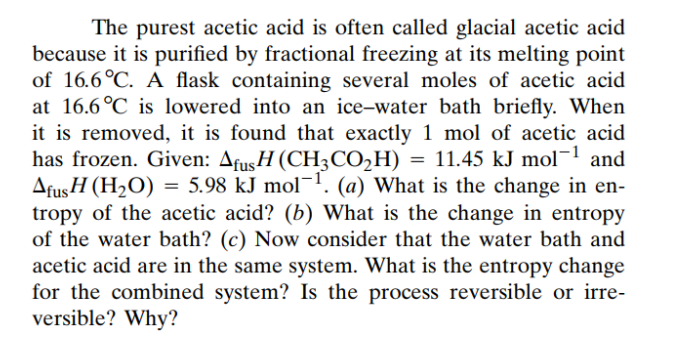The purest acetic acid is often called glacial acetic acid because it is purified by fractional freezing at its melting point of 16.6°C. A flask containing several moles of acetic acid at 16.6°C is lowered into an ice-water bath briefly. When it is removed, it is found that exactly 1 mol of acetic acid has frozen. Given: AfusH (CH3CO₂H) = 11.45 kJ mol-¹ and Afus H (H₂O) = 5.98 kJ mol-¹. (a) What is the change in en- tropy of the acetic acid? (b) What is the change in entropy of the water bath? (c) Now consider that the water bath and acetic acid are in the same system. What is the entropy change for the combined system? Is the process reversible or irre-
The purest acetic acid is often called glacial acetic acid because it is purified by fractional freezing at its melting point of 16.6°C. A flask containing several moles of acetic acid at 16.6°C is lowered into an ice-water bath briefly. When it is removed, it is found that exactly 1 mol of acetic acid has frozen. Given: AfusH (CH3CO₂H) = 11.45 kJ mol-¹ and Afus H (H₂O) = 5.98 kJ mol-¹. (a) What is the change in en- tropy of the acetic acid? (b) What is the change in entropy of the water bath? (c) Now consider that the water bath and acetic acid are in the same system. What is the entropy change for the combined system? Is the process reversible or irre-
Chemistry for Engineering Students
4th Edition
ISBN:9781337398909
Author:Lawrence S. Brown, Tom Holme
Publisher:Lawrence S. Brown, Tom Holme
Chapter9: Energy And Chemistry
Section: Chapter Questions
Problem 9.101PAE
Related questions
Question

Transcribed Image Text:The purest acetic acid is often called glacial acetic acid
because it is purified by fractional freezing at its melting point
of 16.6°C. A flask containing several moles of acetic acid
at 16.6°C is lowered into an ice-water bath briefly. When
it is removed, it is found that exactly 1 mol of acetic acid
has frozen. Given: AfusH (CH3CO₂H) = 11.45 kJ mol−¹ and
AfusH (H₂O) = 5.98 kJ mol-1. (a) What is the change in en-
tropy of the acetic acid? (b) What is the change in entropy
of the water bath? (c) Now consider that the water bath and
acetic acid are in the same system. What is the entropy change
for the combined system? Is the process reversible or irre-
versible? Why?
Expert Solution
This question has been solved!
Explore an expertly crafted, step-by-step solution for a thorough understanding of key concepts.
This is a popular solution!
Trending now
This is a popular solution!
Step by step
Solved in 3 steps with 3 images

Knowledge Booster
Learn more about
Need a deep-dive on the concept behind this application? Look no further. Learn more about this topic, chemistry and related others by exploring similar questions and additional content below.Recommended textbooks for you

Chemistry for Engineering Students
Chemistry
ISBN:
9781337398909
Author:
Lawrence S. Brown, Tom Holme
Publisher:
Cengage Learning

Chemistry
Chemistry
ISBN:
9781305957404
Author:
Steven S. Zumdahl, Susan A. Zumdahl, Donald J. DeCoste
Publisher:
Cengage Learning


Chemistry for Engineering Students
Chemistry
ISBN:
9781337398909
Author:
Lawrence S. Brown, Tom Holme
Publisher:
Cengage Learning

Chemistry
Chemistry
ISBN:
9781305957404
Author:
Steven S. Zumdahl, Susan A. Zumdahl, Donald J. DeCoste
Publisher:
Cengage Learning


Chemistry: An Atoms First Approach
Chemistry
ISBN:
9781305079243
Author:
Steven S. Zumdahl, Susan A. Zumdahl
Publisher:
Cengage Learning

Chemistry: Principles and Reactions
Chemistry
ISBN:
9781305079373
Author:
William L. Masterton, Cecile N. Hurley
Publisher:
Cengage Learning

General Chemistry - Standalone book (MindTap Cour…
Chemistry
ISBN:
9781305580343
Author:
Steven D. Gammon, Ebbing, Darrell Ebbing, Steven D., Darrell; Gammon, Darrell Ebbing; Steven D. Gammon, Darrell D.; Gammon, Ebbing; Steven D. Gammon; Darrell
Publisher:
Cengage Learning